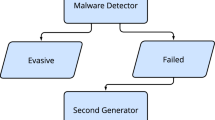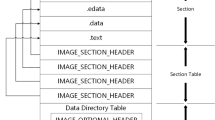Abstract
Early prediction of malicious activity can help prevent irreparable damage caused by rogue actions. A malware analysis tool can anticipate malicious activity and stop the execution of the instance based on API calls to avoid the damage caused by the malware. The anticipation operation examines signatures as behaviors defined in a hierarchical model based on atomic behaviors and API calls. We define atomic behaviors as benign behaviors commonly observed in legitimate and malicious activities. Moreover, the hierarchical model is a reconstruction of the sequence of API calls, called activity or behavior, with atomic behaviors. A sequence of API calls is modeled as a behavior graph, and we use graph mining techniques to derive atomic behaviors and behavior signatures. Behavioral signatures are explored as the most common sequences of API calls observed in malicious behavior graphs. To this end, we used our formula \(H_{test}\) for ranking malicious behaviors. We then compared our signatures with those generated by the two well-known behavior signature generation techniques, CDG and CMQDG. The comparison results provide a reasonable indication of the superiority of our proposed method with an accuracy of 95.86% and an F1 of 95.72%. It also yields a micro F1 of 95.8% in early detection and prevention of malicious activities before any harm can occur.






Similar content being viewed by others
References
Alaeiyan, M., Dehghantanha, A., Dargahi, T., Conti, M., Parsa, S.: A multilabel fuzzy relevance clustering system for malware attack attribution in the edge layer of cyber-physical networks. ACM Trans. Cyber-Phys. Syst. 4(3), 1–22 (2020)
Alaeiyan, M., Parsa, S., Conti, M.: Analysis and classification of context-based malware behavior. Comput. Commun. 136, 76–90 (2019)
Alaeiyan, M.H., Parsa, S.: Automatic loop detection in the sequence of system calls. In 2015 2nd International Conference on Knowledge-Based Engineering and Innovation (KBEI), pp. 720–723. IEEE (2015)
Alazab, M., Venkataraman, S., Watters, P.: Towards understanding malware behaviour by the extraction of api calls. In Cybercrime and Trustworthy Computing Workshop (CTC), 2010 Second, pp. 52–59. IEEE (2010)
Amer, E., Zelinka, I., El-Sappagh, S.: A multi-perspective malware detection approach through behavioral fusion of api call sequence. Comput. Secur. (2021). https://doi.org/10.1016/j.cose.2021.102449
Ashik, M., Jyothish, A., Anandaram, S., Vinod, P., Mercaldo, F., Martinelli, F., Santone, A.: Detection of malicious software by analyzing distinct artifacts using machine learning and deep learning algorithms. Electronics 10(14), 1694 (2021)
avtest: Malware statistics and trends report | av-test. https://www.av-test.org/en/statistics/malware/. Date: 01/18/2021
Chen, Z.G., Kang, H.S., Yin, S.N., Kim, S.R.: Automatic ransomware detection and analysis based on dynamic api calls flow graph. In Proceedings of the International Conference on Research in Adaptive and Convergent Systems, pp. 196–201. ACM (2017)
D’Angelo, G., Ficco, M., Palmieri, F.: Association rule-based malware classification using common subsequences of api calls. Appl. Soft Comput. 105, 107234 (2021)
Ding, Y., Xia, X., Chen, S., Li, Y.: A malware detection method based on family behavior graph. Comput. Secur. 73, 73–86 (2018)
Elhadi, A..A..E., Maarof, M..A., Barry, B.I., Hamza, H.: Enhancing the detection of metamorphic malware using call graphs. Comput. Secur. 46, 62–78 (2014)
Forrest, S., Hofmeyr, S.A., Somayaji, A., Longstaff, T.A.: A sense of self for unix processes. In Proceedings 1996 IEEE Symposium on Security and Privacy, pp. 120–128. IEEE (1996)
Galal, H.S., Mahdy, Y.B., Atiea, M.A.: Behavior-based features model for malware detection. J. Comput. Virol. Hack. Tech. 12(2), 59–67 (2016)
Gao, Y., Lu, Z., Luo, Y.: Survey on malware anti-analysis. In Fifth International Conference on Intelligent Control and Information Processing (ICICIP), pp. 270–275. IEEE (2014)
Han, W., Xue, J., Wang, Y., Huang, L., Kong, Z., Mao, L.: Maldae: Detecting and explaining malware based on correlation and fusion of static and dynamic characteristics. Comput. Secur. 83, 208 (2019)
Karbalaie, F., Sami, A., Ahmadi, M.: Semantic malware detection by deploying graph mining. Int. J. Comput. Sci. Issues (IJCSI) 9(1), 373–379 (2012)
Ki, Y., Kim, E., Kim, H.K.: A novel approach to detect malware based on api call sequence analysis. Int. J. Distrib. Sens. Netw. 11(6), 1–9 (2015)
Kumar, A.V., Vishnani, K., Kumar, K.V.: Split personality malware detection and defeating in popular virtual machines. In Proceedings of the Fifth International Conference on Security of Information and Networks, pp. 20–26. ACM (2012)
Liu, S., Feng, P., Wang, S., Sun, K., Cao, J.: Enhancing malware analysis sandboxes with emulated user behavior. Comput. Secur. p. 102613 (2022)
Luh, R., Schramm, G., Wagner, M., Janicke, H., Schrittwieser, S.: Sequin: a grammar inference framework for analyzing malicious system behavior. J. Comput. Virol. Hack. Tech. pp. 1–21 (2018)
Lundsgård, G., Nedström, V.: Bypassing modern sandbox technologies (2016). Student Paper
Mahindru, A., Sangal, A.: Semidroid: a behavioral malware detector based on unsupervised machine learning techniques using feature selection approaches. Int. J. Mach. Learn. Cybern. 12(5), 1369–1411 (2021)
MalwareBazaar: Malwarebazaar. https://bazaar.abuse.ch. Date: 2/22/2022
Martignoni, L., Stinson, E., Fredrikson, M., Jha, S., Mitchell, J.C.: A layered architecture for detecting malicious behaviors. In International Workshop on Recent Advances in Intrusion Detection, pp. 78–97. Springer (2008)
Miao, Q., Liu, J., Cao, Y., Song, J.: Malware detection using bilayer behavior abstraction and improved one-class support vector machines. Int. J. Inf. Secur. 15(4), 361–379 (2016)
Ming, J., Xin, Z., Lan, P., Wu, D., Liu, P., Mao, B.: Impeding behavior-based malware analysis via replacement attacks to malware specifications. J. Comput. Virol. Hack. Tech. 13(3), 193–207 (2017)
Mpanti, A., Nikolopoulos, S.D., Polenakis, I.: A graph-based model for malicious software detection exploiting domination relations between system-call groups. In 9th International Conference on Computer Systems and Technologies, pp. 20–26. ACM (2018)
Naderi, H., Vinod, P., Conti, M., Parsa, S., Alaeiyan, M.H.: Malware signature generation using locality sensitive hashing. In International Conference on Security and Privacy, pp. 115–124. Springer (2019)
Péchoux, R., Ta, T.D.: A categorical treatment of malicious behavioral obfuscation. In International Conference on Theory and Applications of Models of Computation, pp. 280–299. Springer (2014)
portableapps: portableapps. www.portableapps.com. Date: 2/22/2022
portablefreeware: portablefreeware. www.portablefreeware.com. Date: 2/22/2022
Ranu, S., Singh, A.K.: Graphsig: A scalable approach to mining significant subgraphs in large graph databases. In Data Engineering, 2009. ICDE’09. IEEE 25th International Conference on, pp. 844–855. IEEE (2009)
Singh, J., Singh, J.: A survey on machine learning-based malware detection in executable files. J. Syst. Arch. 112, 101861 (2021). https://doi.org/10.1016/j.sysarc.2020.101861
Souri, A., Hosseini, R.: A state-of-the-art survey of malware detection approaches using data mining techniques. HCIS 8(1), 3 (2018)
Ucci, D., Aniello, L., Baldoni, R.: Survey of machine learning techniques for malware analysis. Comput. Secur. 81, 123-147 (2019)
Usman, N., Usman, S., Khan, F., Jan, M.A., Sajid, A., Alazab, M., Watters, P.: Intelligent dynamic malware detection using machine learning in ip reputation for forensics data analytics. Futur. Gener. Comput. Syst. 118, 124–141 (2021)
virusshare: virusshare. www.virusshare.com. Date: 9/1/2021
Wüchner, T., Cisłak, A., Ochoa, M., Pretschner, A.: Leveraging compression-based graph mining for behavior-based malware detection. IEEE Trans. Depend. Secure Comput. 16(1), 99–112 (2017)
Author information
Authors and Affiliations
Corresponding author
Additional information
Publisher's Note
Springer Nature remains neutral with regard to jurisdictional claims in published maps and institutional affiliations.
Rights and permissions
About this article
Cite this article
Alaeiyan, M., Parsa, S. A hierarchical layer of atomic behavior for malicious behaviors prediction. J Comput Virol Hack Tech 18, 367–382 (2022). https://doi.org/10.1007/s11416-022-00422-5
Received:
Accepted:
Published:
Issue Date:
DOI: https://doi.org/10.1007/s11416-022-00422-5




